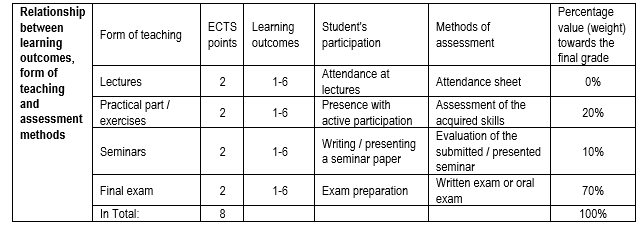Acquiring fundamental knowledge on morphology of individual organs and organ systems of humans. The acquired knowledge in anatomy has to provide students with better understanding of physiologic, physiopathological and pathologic processes in the body as well as teach them skills through clinical courses and procedures of nursing care.
The course includes acquiring knowledge in general anatomy and knowledge about the structure and function of individual organs and organ systems. The course consists of the following:
1. general anatomy (define and differentiate anatomy within morphologic sciences; define and differentiate levels of structural organisation of the human body; define the term and practical significance of anatomical orientation and anatomical position of the body, describe and show positions of the three basic anatomical planes of the human body);
2. general and specialised osteology (describe basic features of the macroscopic structure of bones, analyse and compare shapes of bones, describe and show on an anatomical specimen: the parts of the typical cervical , thoracic and lumbar vertebrae, as well as the sacrum and coccyx, describe the basic characteristics of the spine (vertebral column) as a whole, show parts of the ribs, describe the sternum, describe the skull as a whole, define general features of cranial bones, differentiate, describe and show on anatomical specimens the basic parts of the arm and leg bones);
3. general and specialised sindesmology (synarthroses and diarthroses, define types of joints according to shape and movement, analyse types of junctions between the vertebrae, junctions of the thoracic part of the spine with the ribs and the sternum and describe the thorax as a whole, explain the importance of the shape and position of the ribs within the thorax for the mechanics of breathing, define the junctions between the cranial bones and describe their functional significance);
4. general and specialised myology (describe the structure and parts of the skeletal muscles, define the shapes of skeletal muscles and function of muscles, describe and define their function and innervation);
5. general and specialised neurology (describe the structure of nervous tissue, analyse and compare the anatomical and physiological division of the nervous system, define the brain /encephalon/ and parts of the brain (cerebrum, cerebellum, brainstem), describe the cerebrum, show on an anatomical specimen the lobes of the cerebrum, show where they are separated, describe and show surfaces, fissures and cerebral gyri. Describe the inner structure of the cerebrum, define cover (pallium), deep grey (basal ganglia) and white matter of the cerebrum. Show on an anatomical specimen the position , parts and boundaries of the lateral ventricle, describe the cerebellum, describe the brainstem, define and show on an anatomical specimen the position and division of the parts of the brainstem (medulla oblongata, pons, midbrain/mesencephalon), describe the spinal cord, reflex arch, differentiate reflex arches in the cerebrospinal system, in the parasympathetic and sympathetic part of the autonomous nervous system, describe the meninges of the brain, define the pathways of the nervous system, differentiate cranial and spinal nerves, ganglia, describes types of tissue, exits, branching and area of innervation, nerve plexuses, define the autonomous nervous system, analyse the anatomical and functional difference between parasympathetic and sympathetic nervous system);
6. general and specialised angiology (describe and define the types of blood vessels, describe the structure of the walls of blood vessels, describe the blood circulation, describe the structure of the heart wall, describe the layers of the heart wall; describe the shape and characteristics of the four cavities of the heart; show them on an anatomical specimen, describe the heart orifices, define the conduction system of the heart and explain its structure and function, describe lavage and innervation of the heart and analyse the topography of the heart. Describe the pulmonary circulation and the systemic circulation, define and differentiate their function; define lymphatic vessels and lymphatic node, show and describe the shape and position of the spleen);
7. general and specialised splanchnology (define the difference between the structure and the shape of the hollow organs and parenchymal organ, describe serous membranes, describe the shape and the structure of the organs of the digestive system, and show on an anatomical specimen the basic parts of the mentioned organs as well as position in the body cavities, describe the topography of the digestive organs in the abdominal cavity, explain the division of the abdominal cavity into the peritoneal cavity and extra-peritoneal structures, describe the shape and structure of the organs of the respiratory system, define pleura, pleural cavity and explain the characteristics of the pleura for the mechanics of breathing, describe the shape and the structure of the organs of the urinary systems and the topography of the urinary system, define the internal and external organs of female and male genital system, define the endocrine gland and describe its shape and structure);
8. skin and special and special senses (define the system of the sensory organs, describe the shape and internal structure of the eye, ear, olfactory organ, gustatory organ, vestibulocochlear organ and the skin).
Obavezna literatura:
- Bajek S, Bobinac D, Jerković R, Malnar D, Marić I. Sustavna anatomija čovjeka. Rijeka: Digital point d.o.o.; 2007.
- Keros P, Pećina M, Ivančić-Košuta M. Temelji anatomije čovjeka. Zagreb: Medicinska biblioteka; 1999.
- Paulsen F, Waschke J. Sobotta: Atlas anatomije čovjeka. Jastrebarsko: Naklada Slap; 2007.
Dopunska literatura:
1. Bobinac D., Dujmović M.: Osnove anatomije, Glosa, Rijeka, 2003.
Upon completion of this course, students will be able to:
- Argue facts and theoretical knowledge from the general anatomy and structure of organs and organ systems;
- Analyze the structural organization of the human body and life functions;
- Explain pathophysiological and pathological processes in the body;
- Use new knowledge in mastering subjects from clinical medicine and nursing procedures;
- Support an integrated approach to health and disease, and the cell and the organism as an integrated system;
- Interpret standard physiological and anatomical values.



